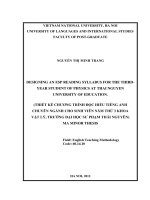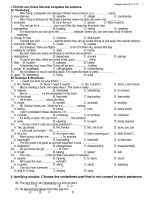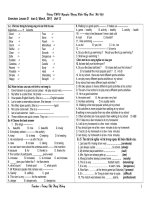Unit 5anh7 hay hay
Bạn đang xem bản rút gọn của tài liệu. Xem và tải ngay bản đầy đủ của tài liệu tại đây (497.6 KB, 8 trang )
<span class='text_page_counter'>(1)</span>Planning date: 8.10.11. Period 26.. Unit 5: work and play Lesson 1: a1,3.. I. Aims: - To help ss review the present simple tense to talk about school subjects. - Students read a dialogue between Lan and Hoa to practice more about the subject Math. - To develop ss’ skills. II. Objectives: By the end of the lesson, ss will be able to talk about school subjects. III. Ways of working: T-WC, team work, pair work, individual work. IV. Materials: Text book, pictures, additional board. V. Anticipated problems: The writing activities may be difficult for some ss. VI. Teaching steps: 1. Warm up: (1 minutes) Greet and check the ss’attendance. 2. Revision: 3. New lesson: STAGES ACTIVITIES ON BOARD PRESENTA * Preteach: I. New words: TION - T. uses techniques to teach ss (to) learn about: häc vÒ... (12 new words (to) use: dïng, sö dông minutes) How to use: dïng nh thÕ nµo (to) be interested in: thÝch a map: bản đồ an experiment: thÝ nghiÖm last(adj): cuèi cïng - Checking understanding: * What and where. What and where.. * Presentation text: A1. P.51: - T. plays the tape, ss listen and repeat. PRACTICE. (15 minutes). PRODUCTI ON. (15. * Grid: (with answer key) - Ss read the text and fill in the grid.. * Word cue drill: - Ss use the grid to make questions and answer about what Mai does in her class. E.g: S1: What does Mai do in her computer science class? S2: She learn how to use a computer. * Questions and answer: (Writing). ((aa ttn II. Fill information in the grid: o om Classes What to do ) Computer to learn how to use a l)eap bx science computer e u ep Geography to study map and a s learn about different rie enr countries nti Physics to do some em experiments are ben ost ut te d i n III. Answer the questions and then write them in paragraph:.
<span class='text_page_counter'>(2)</span> minutes). - Ss answer the questions and then write about their classes. E.g: Our classes always begin at 1 p.m. At school, we learn about different things. In our Computer Science class, we learn how to use a computer. In our Geography class, we study maps and learn about different countries. In our last lesson, we do some experiments. It’s a Physics class. Our classes end at 5.15 p.m. * Reading: A3. P.53 - Students read the dialogue in pair and answer the questions: 1. How much do the bananas cost according to Hoa’s answer? 2. What is the correct answer?. 1) What time do your classes begin? 2) What do you learn at school? 3) What do you do in your Computer Science class? 4) What do you study in your Geography class? 5) What do you do in your last lesson? 6) What time do your classes end?. IV. Reading: A3. P.53 Note: (to) cost: cã gi¸ (tiÒn lµ) price (n): gi¸ c¶ one: c¸i, chiÕc...........(dïng thay thÕ cho một danh từ số ít đã đợc nhắc đến trớc đó). 4. Homework: (2 minutes) - Learn by heart the new words. - Do exercise: A1. P.27 (work book). Planning date: 8.10.11 Period 27.. Unit 5: work and play Lesson 2: a2.. I. Aims: - To help ss read a text for details about Ba’s activities at school and at home. - To develp ss’skills. II. Objectives: By the end of the lesson, ss will be able to understand the reading. III. Ways of working: T-WC, individual work. IV. Materials: Text book, pictures, additional board. V. Anticipated problems: VI. Teaching steps: 1. Warm up: (1 minute) Greet and check the ss’attendance. 2. Revision: (4 minutes) Hangman: (favorite); (washing machine) 3. New lesson: STAGES PREREADI NG. (11 minutes). ACTIVITIES * Preteach: - T. uses techniques to teach ss new words:. ON BOARD I. New words: (to) enjoy: thÝch (to) repair: söa ch÷a (to) fix: ch÷a, söa ch÷a (to) be good at: giái vÒ electronics (pl): ®iÖn tö häc.
<span class='text_page_counter'>(3)</span> - Checking understanding: Rubout and remember. * T. gives T / F statements and asks ss to predict:. an art club: c©u l¹c bé nghÖ thuËt * Rubout and remember II. True ? False statements prediction: 1) Ba enjoys his school very much. 2) His favorite subject is Electronics. 3) In this class, he does some experiments. 4) He is not good at fixing things. 5) He can help his parents at home. 6) He never goes to art club.. WHILE READING. - Ss read the text and check III. Reading: A2. P.52: their predictions: 1. Checking T / F prediction: * Key: 1) T 3) F 5) T 2) T 4) F 6) F - Ss read again and guess 2. Matching: the meaning of some words: L5. a household applience bøc häa L11. the guitar häa sÜ L12. a drawing thiÕt bÞ gia đình L14. an artist đàn ghita 3. Answer the questions: A2. P.53: - Ss read again and answer * Key: the comprehension a) Ba likes Electronics best. questions: b) Yes, he does. He enjoys school very much. c) He learns to repair household appliances. d) He will be able to fix his own appliances. e) Yes, he is. His drawing are very good. for f) – h): ss’answers.. POSTREAD ING. * Survey: Example exchange: S1: What’s your favorite subject? S2: It’s Physics. S1: What are you good at? S2: I good at doing experiments. S1: What do you do in your free time? S2: I’m going to Physics club.. (20 minutes). (7 minutes). 4. Homework: (2 minutes) - Learn by heart the new words. - Do exercise: A2. P.28. (work book). IV. Survey: Name. Favorite good at subject. free time activities. Hoa. Math. ................ ...............
<span class='text_page_counter'>(4)</span> Planning date: 14.10.11. Period 28.. Unit 5: work and play Lesson 3: a4 - 6.. I. Aims: - To help ss know some school subject vocabulary with listening and reading practice. - To develp ss’skills. II. Objectives: By the end of the lesson, ss will be able to do all the task. III. Ways of working: T-WC, pair work, team work, individual work. IV. Materials: Text book, pictures, tape. V. Anticipated problems: VI. Teaching steps: 1. Warm up: (1 minute) Greet and check the ss’attendance. 2. Revision: (4 minutes) Matching Ss match A4. P.54 and the subjects: Computer Science, Physical Education, Geography, Electronics, Class activity. 3. New lesson: STAGES ACTIVITIES ON BOARD PRE * Prediction: I. Prediction: LISTENING - Ss predict what subject Hoa / What subject does Ba / Hoa have on (2 Ba has on Saturday morning. Saturday morning? minutes) - Ss write the name Ba / Hoa Ba: 1:.............. Hoa: 1: ........... next to the picture. 2: ............. 2: ............ 3: ............. 3: ............. WHILE - Ss listen and check their II. Listening: A4. P.54: LISTENING predictions. Ba: d, a, e. (6 Hoa: c, b, e. * Tapescript: minutes) On Saturday morning, Ba and Hoa go to school. Some of the subjects they do on Saturday are the same, but some of them are different. At seven o’clock, Ba has Technology and Hoa has Computer science class. These classes last for two periods. At 8.40, Ba has Geography. Hoa does not have Geography on Saturday. She has Physical Education instead. In the last period, they have the same class. Hoa and Ba both have class activities then. * Preteach: III. New words: PRE an essay: bµi v¨n READING calculator: m¸y tÝnh (12 an event: sù kiÖn minutes) past and present event: sù kiÖn ë qu¸ khø vµ hiÖn t¹i. * Matching: A6. P.55 IV. Matching: A6. P.55 Physical piano, guitar,.
<span class='text_page_counter'>(5)</span> Education Geography. songbooks graphs, equations, calculator Music game, running shoes, ball. Art maps, globe, atlas Math paint, pencils, paper - T. gives ss the meaning of piano: đàn pi a nô some words. (passive words) graph: biểu đồ equation: c«ng thøc globe: quả địa cầu / trái đất atlas: sách bản đồ (to) paint: vÏ WHILE * A5. P.54: IV. Answer these questions: READING Ss read the text and answer the 1) What do you study at school? (10 comprehension questions: 2) What do you learn in Literature? minutes) 3) Do you study past and present events in History? 4)What subject do you learn about different countries and their people? 5) Do you speak English in Language class? 6) What other things do you study? * Answer key: 1) We study many things. 2) We learn about books and write essays. 3) Yes, we do. 4) It’s Geography. 5) Yes, we do. 6) We study music, sports and art. POST * Noughts and crosses: * Noughts and crosses: READING E.g: History Language Art (7 S1: What do you do in History? Physics Computer Math minutes) S2: We study past and present Science events. Literature Electronics Geography 4. Homework: (2 minutes) - Learn by heart the new words and read A5. P.54 again. - Do exercise: write a passage about your subjects.. Planning date: 14.10.11. Period 29.. Unit 5: work and play Lesson 4: b1,2.. I. Aims: - To help ss know some recess activities and vocabulary. Ss review the present progressive, present simple tenses. - To develop ss’skills. II. Objectives: By the end of the lesson, ss will be able to use the present progressive tense to talk about some activities at recess. III. Ways of working: T-WC, pair work, team work, individual work. IV. Materials: Text book, pictures, tape. V. Anticipated problems: The lesson may take time. VI. Teaching steps: 1. Warm up: (1 minute) Greet and check the ss’attendance. 2. Revision: (5 minutes) Noughts and crosses.
<span class='text_page_counter'>(6)</span> Teacher’s notes: a b c a) Music; b) Math; c) Literature d) English; e) Physics; f) Geography d e f g) History; h) Electronics; i) Computer Science E.g: a) S1: In this subject we learn to sing songs. g h i 3. New lesson: STAGES ACTIVITIES ON BOARD PRESENTA * Preteach: I. New words: TION T. uses techniques to teach ss (to) skip rope: nh¶y d©y (17 new words. (to) talk about: nãi chuyÖn vÒ... minutes) (use pictures on page 56) (to) chat: t¸n gÉu (to) play marbles: ch¬i bi (bluff: sù lõa bÞp blindman’s bluff: ch¬i bÞt (v): bÞp lõa g¹t) m¾t b¾t dª. catch: ch¬i ®uæi b¾t (to) have fun: ch¬i trß vui (to) ring: reo, kªu leng keng - Checking understanding: * What and where: What and where. play catch talk about have fun * Presentation text:B1. P.56 - T. plays the tape, ss listen and then read the text to complete the list.. Q: Để diễn tả hoạt động đang x¶y ra trong giê ra ch¬i em dïng th× nµo? Form? PACTICE. (10 minutes). FURTHER PRACTICE. (10 minutes). LISTENING. (5 minutes). * B1a. P.57: (Picture cue drills. P.56) E.g: S1: What are these boys doing? S2: They are playing catch. * B1b. P.57 - Students pracite in pair asking and answering about the activities they do at recess and after school. * Write it up: - Ss describe the activities at recess, basing on the pictures on page 56.. ring. chat. II. Recess activities: E.g: meeting friend skipping rope ................... * The most popular activity is........... * Answer key: Recess activities: Meeting friend chatting talking eating playing mables drinking skipping rope * The most popular activity is talking. III. Practice:. * Writing: E.g: There are three boys playing mables. Or: At recess, some boys are playing mables in the school yard. Some girls are eating and drinking............ IV. Listen and match: B2. P.57. *Listen: B2. P.57: - Students listen and match the * Key: name with the activities. Mai * Tapescript: Kien It is recess and the yard is very Lan. playing catch playing marbles skipping rope.
<span class='text_page_counter'>(7)</span> crowded and noisy. Mai and Ba Bi are playing catch. Kien is laying blindman’s bluff with some friends. Ba is playing marbles and Lan is skipping rope. They are all having a good time. 4. Homework: (2 minutes) - Learn by heart the new words and read B1 again. - Do exercise: B1. P.30 - 31 (work book). - Prepare B3 (text book). Planning date: 14.10.11 Period 30.. playing blindman’s bluff. Unit 5: work and play Lesson 5: b3,4.. I. Aims: - To help ss read for details about recess activities in an American school. - To help students use the present simple tense to talk about activities at recess. - To develop ss’skills. II. Objectives: By the end of the lesson, ss will be able to understand the reading and do all the task. III. Ways of working: T-WC, pair work, individual work. IV. Materials: Text book, additional board. V. Anticipated problems: The lesson may take time. VI. Teaching steps: 1. Warm up: (1 minute) Greet and check the ss’attendance. 2. Revision: (5 minutes) Ss tell some activities they usually do at the recess. 3. New lesson: STAGES PRE READING. (10 minutes). WHILE READING. (15 minutes). ACTIVITIES ON BOARD * Preteach: I. New words: - T. uses techniques to teach ss a junior high school: trêng cÊp 2 new words. (to) score a goal: ghi bµn (to) swap: đổi, trao đổi - Checking understanding: (to) relax: th gi·n, nghØ ngh¬i Rubout and remember. (to) take part in: tham gia - Ss predict what ss in II. Prediction: American schools do at recess. What do students in American schools do at recess? - Talking ................. - Ss read the text to check their III. Reading:B3. P.57 - 58: prediction. 1. Matching: - Ss read again and guess the meaning of the words given: L1:pen pal kh¾p thÕ giíi L6: energetic b¹n qua th L13-14: portable nh÷ng gãi kÑo CD players L18: mainly m¸y nghe CD x¸ch tay L19: packets of nh÷ng häc sinh.
<span class='text_page_counter'>(8)</span> candy L22: world wide. Ss read again and do the multiple choice (a, b, c, d). P.58 POST READING. (12 minutes). * Discussion: - Ss compare the recess activities of Vietnamese students and American students.. năng động chñ yÕu. 2. Multiple choice: * Key: a) C b) A c) D d) D 3. Talking: E.g: In Vietnam, students usually talk, play mables, skip........................at recess. In American, students usually............... .............................................................. III. Survey:B4. P.57:. . other. . talk. X. read. . marbles. . skip rope. X. catch. Lan. ACTIVITIES soccer. * Survey: B4. P.57: E.g: S1: What do you usually do at recess, Lan? S2:I usually skip rope and play Name catch. I sometimes read and talk with others.. X. Tuan. * Write it up: - Students base on their survey IV. Writing: to write sentences Example: Lan usually skips rope and play catch. She sometimes reads and talks with her friends. 4. Homework: (2 minutes) - Learn by heart the new words and read B3. P.57 - 58 again. - Do exercise: B3. P. 32 (workbook) * T. guides ss to do the exercise..
<span class='text_page_counter'>(9)</span>









